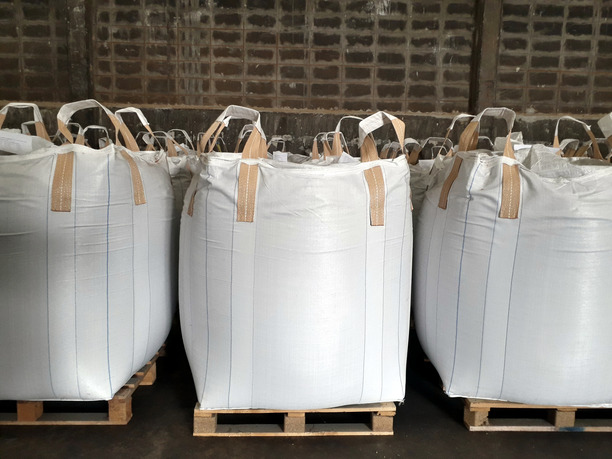
Antistatic bags are specialized packaging designed to protect sensitive materials from static electricity. By preventing static discharge, these bags help avoid damage or dangerous conditions, especially in environments where combustion risks are present. They are crucial for handling materials in industries such as pharmaceuticals, food-grade applications, and chemicals.
At United Bags, our Antistatic FIBCs are made from non-conductive polypropylene woven with conductive threads in a grid pattern. This unique design eliminates the need for grounding, making them ideal for transporting flammable powders and working safely around flammable vapors or dust. Our team at United Bags is here to help you select the right antistatic bags for your needs, ensuring both safety and efficiency in your operations.
What is Static Electrical Current? Why is It Harmful?
Static electrical current, or static electricity, builds up when items rub against each other, transferring electrons and creating a charge. This can happen during packaging and transit as items shift and move around.
In pharmaceuticals and chemicals, static discharge can potentially contaminate or affect the quality of the materials. For food-grade products, static charges can cause clumping or other packaging problems, impacting product safety and integrity. A static spark might even lead to dangerous explosions in environments with flammable chemicals.
Antistatic bags are designed to handle these risks. They safely dissipate static electricity, protecting your sensitive materials during storage and transport. By using antistatic bags, you ensure that your pharmaceuticals, chemicals, and food-grade products remain safe and in top condition, free from the potential harm of static charges.
What Are Antistatic Bags Made Of?
Antistatic bags are designed to manage static electricity effectively. This material is not just static-resistant; it actively helps to dissipate static charges. The bags are made from non-conductive polypropylene, interwoven with conductive threads in a grid pattern. This construction ensures that the bags handle static electricity by safely dispersing charges, rather than allowing them to accumulate. For protecting sensitive materials during storage and transport, antistatic bags are essential to prevent static discharge and ensure product integrity.
What Are Antistatic Bags Used For?
Antistatic bags play a critical role in industries where static electricity can lead to safety risks or product damage. These specialized bags are essential in sectors such as pharmaceuticals, chemicals, mining, and environmental/hazardous materials.
In the pharmaceutical industry, antistatic bags protect sensitive products from harmful static discharge that could affect their quality. Similarly, in the chemical sector, these bags help prevent dangerous static buildup that could lead to unwanted reactions or contamination. The food-grade industry also benefits from antistatic bags by reducing the risk of packaging failures or clumping, ensuring product safety.
In hazardous environments, such as mining operations, antistatic bags are especially crucial. They help minimize the risk of static sparks igniting flammable gases or dust. These bags are also widely used in hazmat operations where explosive vapors, gases, or solvents may be present, providing an extra layer of safety by controlling static electricity.
No matter the environment, antistatic bags ensure the safety and integrity of your materials, making them an indispensable tool in preventing static-related hazards across various industries.
FIBC Bags and Antistatic Properties
Flexible Intermediate Bulk Containers (FIBCs), also known as Bulk Bags and Totes, are an ideal solution for the transportation and storage of bulk industrial materials. SUPER SACK® bulk bags are one type of FIBC commonly used for those purposes.
These durable bags are designed for efficiency, offering a cost-effective way to handle large quantities of dry goods. FIBCs come in four different types, each catering to specific needs based on the materials being stored or transported.
Type C FIBC bags are made from a special conductive material that must be grounded, providing essential static protection. This grounding capability ensures the safe transport of materials in environments where static sparks could ignite flammable gases, dust, or powders, making them ideal for industries like petrochemicals, pharmaceuticals, and mining.
Type D FIBC bags, on the other hand, are engineered from dissipative material that prevents static buildup without the need for grounding. These bags are your classic antistatic solution and are perfect for environments where flammable substances are present, offering reliable protection against static discharge.
Whether you need Type C bags for static-sensitive environments or Type D bags for advanced antistatic protection, FIBCs provide a versatile and safe option for bulk storage and transportation. Choosing the right type ensures that your materials stay safe and secure.
United Bags Provides the Highest Quality Antistatic Bag Solutions
When it comes to industries where static control is crucial, choosing the right antistatic bag is essential for protecting both your products and your workspace. At United Bags, we understand this importance and are dedicated to offering top-quality solutions tailored to your needs.
Our antistatic bags are crafted from high-grade raw materials and the latest technology to ensure unmatched reliability and performance. United Bags takes pride in our rigorous inspection process, which ensures that every bag meets our stringent standards. Our innovation lab continually works on improving our products, while our vendor-managed inventory guarantees that you’ll always have access to the bags you need, exactly when you need them.
Ready to see the difference? Visit our Bag Inventory page or contact us today.















